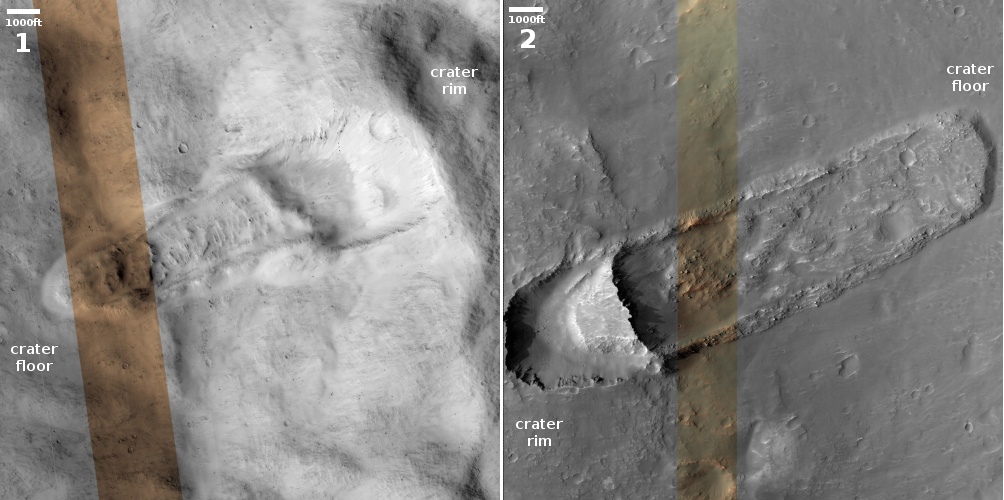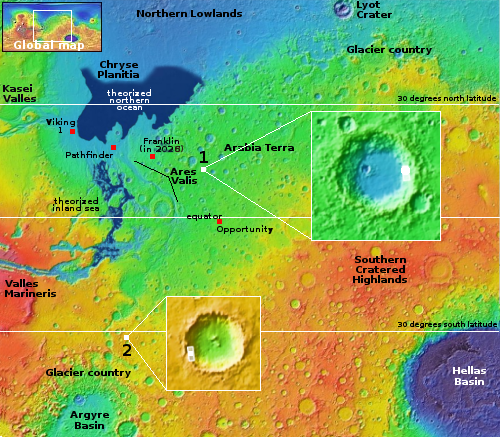Massive Martian landslides

For original images go here and here.

Today’s two cool images above provide a nice sense of the massive nature of many Martian landslides. Scientists often call this kind of slide “mass wasting,” because rather than it occurring because a single rock propagates a larger flow of rocks as it starts rolling downhill, this slide occurs because a large section of the hillside suddenly breaks free and moves downward as a unit, carving a path as it goes.
Mars has a lot of these kinds of slides, likely caused partly by its lower gravity, 39% that of Earth’s.
The overview map to the right marks the location of both slides by their numbers. Number one took place on the eastern interior rim of a 56-mile-wide and 7,000-foot-deep unnamed crater the dry tropics of Mars. The slide dropped about 3,000 feet, beginning about halfway down from the top of the rim and not quite reaching the crater floor. The picture was taken by the high resolution camera on Mars Reconnaissance Orbiter (MRO) on March 31, 2024.
Number two occurred on the western interior rim of a 32-mile-wide and 6,500-foot-deep unnamed crater in the mid-latitudes where near-surface ice and glacial features are often found. In this case the slide fell downward about 3,500 feet. The picture was taken by MRO’s high resolution camera on March 14, 2024.
Despite the different latitudes and thus different climates and geological settings, both landslides look similar. It is possible they occurred under similar conditions, but at very different times. Or it is also possible that the Mars gravity and general environment promotes these mass wasting events everywhere.
On Christmas Eve 1968 three Americans became the first humans to visit another world. What they did to celebrate was unexpected and profound, and will be remembered throughout all human history. Genesis: the Story of Apollo 8, Robert Zimmerman's classic history of humanity's first journey to another world, tells that story, and it is now available as both an ebook and an audiobook, both with a foreword by Valerie Anders and a new introduction by Robert Zimmerman.
The print edition can be purchased at Amazon or from any other book seller. If you want an autographed copy the price is $60 for the hardback and $45 for the paperback, plus $8 shipping for each. Go here for purchasing details. The ebook is available everywhere for $5.99 (before discount) at amazon, or direct from my ebook publisher, ebookit. If you buy it from ebookit you don't support the big tech companies and the author gets a bigger cut much sooner.
The audiobook is also available at all these vendors, and is also free with a 30-day trial membership to Audible.
"Not simply about one mission, [Genesis] is also the history of America's quest for the moon... Zimmerman has done a masterful job of tying disparate events together into a solid account of one of America's greatest human triumphs."--San Antonio Express-News

For original images go here and here.

Today’s two cool images above provide a nice sense of the massive nature of many Martian landslides. Scientists often call this kind of slide “mass wasting,” because rather than it occurring because a single rock propagates a larger flow of rocks as it starts rolling downhill, this slide occurs because a large section of the hillside suddenly breaks free and moves downward as a unit, carving a path as it goes.
Mars has a lot of these kinds of slides, likely caused partly by its lower gravity, 39% that of Earth’s.
The overview map to the right marks the location of both slides by their numbers. Number one took place on the eastern interior rim of a 56-mile-wide and 7,000-foot-deep unnamed crater the dry tropics of Mars. The slide dropped about 3,000 feet, beginning about halfway down from the top of the rim and not quite reaching the crater floor. The picture was taken by the high resolution camera on Mars Reconnaissance Orbiter (MRO) on March 31, 2024.
Number two occurred on the western interior rim of a 32-mile-wide and 6,500-foot-deep unnamed crater in the mid-latitudes where near-surface ice and glacial features are often found. In this case the slide fell downward about 3,500 feet. The picture was taken by MRO’s high resolution camera on March 14, 2024.
Despite the different latitudes and thus different climates and geological settings, both landslides look similar. It is possible they occurred under similar conditions, but at very different times. Or it is also possible that the Mars gravity and general environment promotes these mass wasting events everywhere.
On Christmas Eve 1968 three Americans became the first humans to visit another world. What they did to celebrate was unexpected and profound, and will be remembered throughout all human history. Genesis: the Story of Apollo 8, Robert Zimmerman's classic history of humanity's first journey to another world, tells that story, and it is now available as both an ebook and an audiobook, both with a foreword by Valerie Anders and a new introduction by Robert Zimmerman.
The print edition can be purchased at Amazon or from any other book seller. If you want an autographed copy the price is $60 for the hardback and $45 for the paperback, plus $8 shipping for each. Go here for purchasing details. The ebook is available everywhere for $5.99 (before discount) at amazon, or direct from my ebook publisher, ebookit. If you buy it from ebookit you don't support the big tech companies and the author gets a bigger cut much sooner.
The audiobook is also available at all these vendors, and is also free with a 30-day trial membership to Audible.
"Not simply about one mission, [Genesis] is also the history of America's quest for the moon... Zimmerman has done a masterful job of tying disparate events together into a solid account of one of America's greatest human triumphs."--San Antonio Express-News


I can’t see why lower gravity would lead to more landslides. Since gravity moves the matter in the first place, less gravity means less movement. Maybe it also means less compaction/ consolidation? Mars IS weird!
Gudgeon: You point about gravity makes sense, which is why your conclusion (“Mars is weird.”) is even more correct.
It think the lower gravity means less density, which weakens the structural intergrity of these hillsides. If there is a water/ice layer below ground, this could allow large sections to slide.
I am guessing of course. Real in situ research will be required to really know.
What was the complicated name of that comet that the Europeans visited a few years ago? That thing had very, very low gravity, but the Rosetta spacecraft observing it saw a whole lot of landslides.